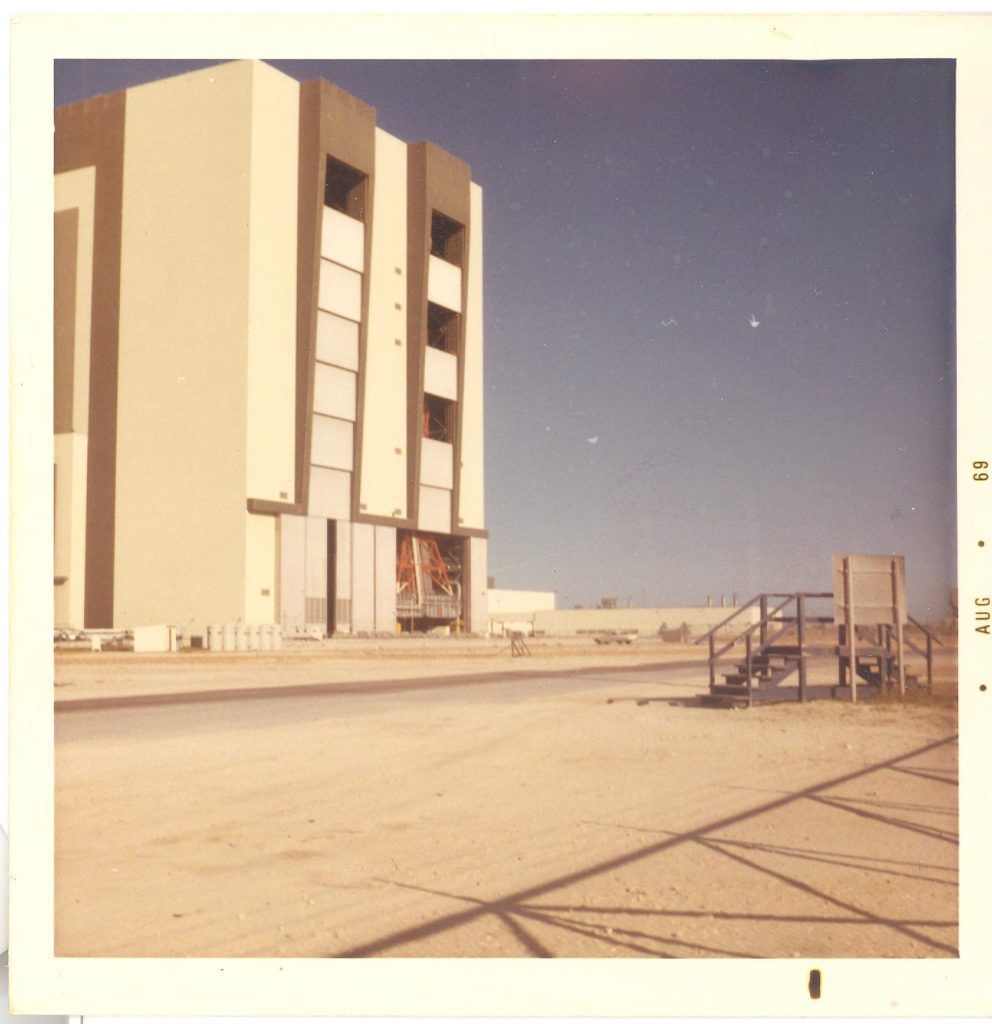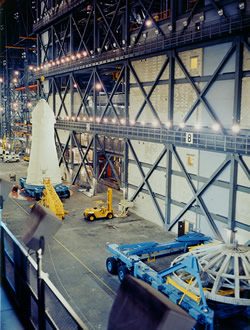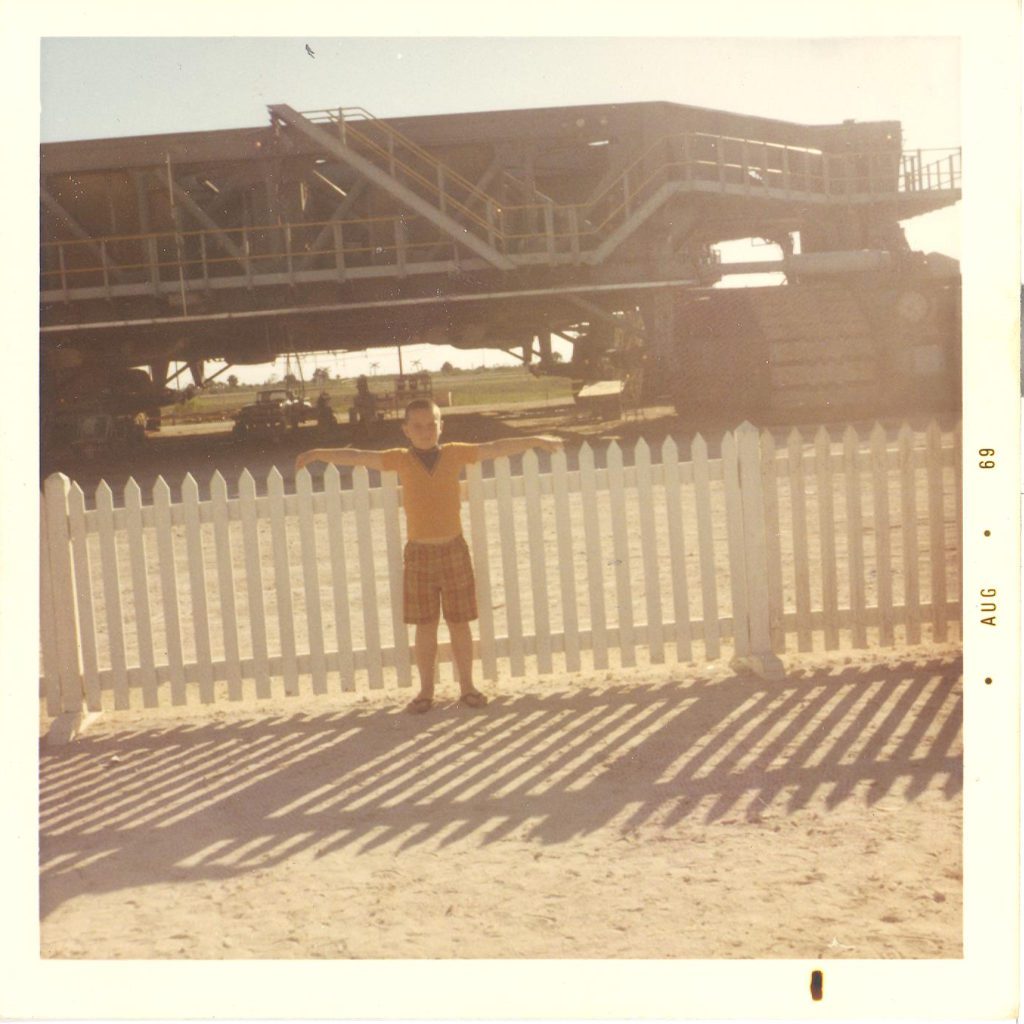| 1969 — The Space Race and a Little Space Cadet Like most little boys in the 1960s, I was totally obsessed with the NASA space program. The early NASA space flights dominated my entire childhood. I was born in April, 1961 — 13 days after Soviet Cosmonaut Yuri Gagarin became the first man in space, but 10 days before American Astronaut Alan Sheppard followed, kicking off the “Space Race.” I entered this world just as man was taking his first steps into space. Being a little kid, I was oblivious to the trouble in the world. Each night, the TV news was full of the Vietnam War and riots in the streets. But the only TV news that interested me showed rockets carrying men into space, reaching new milestones over the span of weeks and months. It’s hard to adequately explain the excitement of the early NASA days to someone who didn’t live through it. In America, the 1960s really were “the best of times and the worst of times.” But if nothing else, 1969 was a great year to be eight years old! Vacation ’69 — Florida! My grandmother and her friend had planned to take a Florida vacation in late June and early July of 1969. I was excited when they invited me to join them. There was only one place in Florida that I wanted to see — the place where the rockets lifted off into space! It’s a long ride from Ohio to Florida. But it was longer in the 60s since the freeway system was still under construction. Most of the trip South was on state and federal routes, through the small towns of Kentucky, Tennessee and Georgia. And there were many hard-to-avoid “tourist traps” that added time to the trip. It took four days each way to get there and back, compared to only 20 hours nowadays. Like many northerners, I was amazed at my first sighting of a palm tree! There is so much to do in Florida, like seeing the sights and swimming in the ocean. And we had to do all that stuff first, since Grandma planned the Kennedy visit for the return trip! We spent that Fourth of July in Miami and a couple days later headed back North. Cape Kennedy — At Last! We cruised up the eastern coast of Florida and approached Cape Canaveral — which was known as “Cape Kennedy” in those days. Following the signs, we were led to the site of the main gate at the Cape Kennedy Administration Building. Driving up to the site was the most exciting thing that had happened in my eight short years! In the front of the building was a “rocket garden” with “life size” models of the actual rockets from the NASA program, for kids to jump and play on. We waited in this area until it was our turn to catch a tour bus that led us through the main gate, into the “inner sanctum” for little space cadets like me! The bus ride was a long, weary tour of the NASA base. We passed many sites where the Mercury and Gemini rockets were launched. The gantries and launch pads for these rockets were still there, though they were no longer in use. The bus lingered at a “Friendship 7” memorial in honor of John Glenn, the first American to orbit the Earth. Who would have known then that this space hero would someday be our Senator from Ohio! The tour bus stopped and let us off in a “blockhouse” — a reinforced concrete bunker near the launch pads, where mission controllers would monitor the launches from “up close.” The room had that plain, white “NASA look,” with rows and rows of consoles — functional perhaps, but not of greatest interest to little boys! I was happy to be at NASA, but we still hadn’t seen the good stuff! But that was finally the next stop! Where Moon Rockets are Made After some more driving, the tour bus finally pulled up to the real destination, that awesome monolith of space travel, the Vehicle Assembly Building! All good 60s space cadets like me knew that the Vehicle Assembly Building was the place where the Apollo rockets were made. This enormous building is shaped almost like a cube, over 500 feet on a side! At the time, it was the largest building in the world, at least insofar as the volume that it held. |

| Vehicle Assembly Building — July 1969 (Note crawler and red gantry inside — probably for Apollo 12) |
The bus parked near the huge brown and white building. The ground was all dusty, even though the site was in the middle of an alligator-infested swamp. There were no other buildings around, and there was no pavement that I could see. The Vehicle Assembly Building was the only structure around that could be seen, except for trees and the dusty parking lot.
Our tour guide led us through one of the giant doors into the place. These doors were made large enough so that the 363-foot Saturn V Apollo Moon rockets could be taken out for launch. The ceiling was so high, it was almost like not being indoors. I’ve heard that the Vehicle Assembly Building is so high and wide open that clouds actually form inside!
Inside the Building, there were the top pieces of two Apollo rockets, sitting side by side. I instantly recognized them as each being the top of the third stage of a Saturn V, with the Command Module that carried the astronauts, the Service Module underneath that propelled the craft to and from the Moon. Under the “CSM” (Command and Service Modules) was the tapered section that opened up to release the LEM, or “Lunar Excursion Module.”

NASA Photo — This NASA archive photo was taken sometime after our visit. The visible top section is Apollo 13 and the empty vehicle in the foreground would have carried Apollo 12.
I gazed in awestruck wonder — these were real space ships! These were only the topmost pieces of a Saturn V, maybe one-quarter of the total Moon rocket. Yet they towered overhead, much taller than most common buildings. My young mind pondered that these rockets that I was staring at would actually go to the Moon. Except for the Command Module, which was the crew capsule, none of these pieces would return to the Earth.
So here were these two Apollo rocket sections, sitting next to each other. Our guide informed us that these were the top sections of Apollo 12 and Apollo 13. Though I didn’t know it until the next April, I had seen with my own eyes the Service Module that exploded en route to the Moon. The system fault that nearly killed the three astronauts of Apollo 13 was already hidden below the panel that I had seen.
Sadly, my Grandma was not allowed to take pictures inside the Vehicle Assembly Building. We were told that because of security during the Cold War, NASA could not risk allowing Soviet Russian agents to photograph our secrets. I was very disappointed, so I burned the image into my memory. But in retrospect, in that simpler era of American life, it’s amazing that they even allowed us into the place at all.
Outside the Vehicle Assembly Building, behind a white picket fence, was one of the giant grey “crawlers.” These are movable launch pads upon which the Apollo rockets were built. Upon assembling the vehicles in the Vehicle Assembly Building, the crawler would slowly roll the giant rocket across the ground to the pad where it would be launched. The one I saw may have been the one upon which Apollo 13 was assembled.

The Author, in front of an Apollo crawler, Kennedy Space Center, 1969
All the things I saw were so big, so incredibly enormous, so mind-boggling to an eight-year-old boy from Cleveland, Ohio. It’s lately been fashionable among the young generation to say the Moonwalks were a hoax, that we never even sent men to the Moon. All I can say as an eyewitness is that NASA certainly constructed some very elaborate props to fool everyone!
On the Pad
We got back on the bus, but the tour was not yet over — we had one last stop. After all, it was early July, 1969, and everyone knew that an historic launch was scheduled, less than two weeks away, on July 16. The bus started down the dusty road to Pad 39, upon which the crawler took the Saturn V. We were allowed to get out of the bus one last time, but only from a safe distance away.

Apollo 11 — July, 1969
Medium — Kodak Instamatic
(c) 1969 Mrs. Florence Antos
There it was, before our eyes, the Moon Rocket itself — Apollo 11! We were quite far away but there was no mistaking the gigantic Saturn V off in the distance. In addition to the red launch gantry, there was the other grey gantry used to move the craft. My Grandma tried to walk a bit closer to snap a better picture with her Kodak. In these pictures, Apollo 11 is silouetted by the afternoon Sun, but the familiar black and white markings can still be seen. After seeing such wonders of the modern era, our tour was over. We left Cape Kennedy and I was elated! We stayed in a motel in Titusville, Florida, and the motel was next to a lake. As the Sun set on that amazing day, I looked out over the water behind the motel and saw the Vehicle Assembly Building off in the distance, as twilight overtook the scene….
The Moon Landing
Like every other kid, I got up on the morning of July 16 to watch the launch of Apollo 11. It was so cool to see the rocket on TV, after just seeing it in person only a handful of days before. The TV showed a constant image of the rocket on the pad, with a countdown clock ticking away the seconds. The soundtrack was mostly “NASA-speak” — the strange engineering lingo of the mission controllers. It would no doubt be boring television by today’s standards, since glitzy computer effects were still decades away. But we were content to see history being made as it happened.
The engines roared to life as the clocked counted down to zero. “Liftoff — we have liftoff,” said the mission controller as Neil Armstrong, Buzz Aldrin and Michael Collins embarked on their trip to the Moon. The cameras stayed on the Saturn V as it rose into the blue Florida sky. We could see the first stage drop away as the second stage ignited. Then the second stage itself fell away as the rocket with its third stage entered Earth orbit.
The Apollo 11 coverage continued for hours as the rocket orbited the Earth. I liked the ABC News because they had science correspondent Jules Bergman, who gave the best explanations. After the main excitement was over, the network broke away for some commercials. The best ones were for “Tang,” which was this awful-tasting orange drink mix. But all us kids drank Tang anyway because it was “The Drink the Astronauts Took to the Moon.” Plus, they had these funny cartoons with little alien “Moon Men” who were excited that the astronauts were coming to visit!
As the next four days passed, the news was filled with the mission progress, and more excellent explanations from Jules Bergman. We heard the voices from Apollo, but these were hard to follow, since they were in pure NASA-speak. And they sounded like a they were talking into a tin can through a pillow, with a good bit of static, and a short time delay for the sound signal to reach Earth. Plus, every so often there was this beep — always that beep! I could never figure out what was the story with that beep! The soundtrack of Apollo sounded something like this:
Apollo: Houston, we have a transverse bidirectional port manifold indicator of 35 pounds.
(pause)
Houston: Roger that.
(beep!)
Clearly, if NASA wanted to fake the Moon missions, they could have made the dialog more interesting!
The Landing
After several days in space, Apollo 11 finally reached the Moon. The TV screen was filled with the image from the camera on board the Lunar Module, named “The Eagle” by Commander Armstrong. We saw Moon craters pass underneath while Neil Armstrong looked for a place to land. It was hard to interpret the black and white image because it was quite indistinct, being sent 240,000 miles through space. To my young eyes, the crater images appeared inverted. The craters did not look circular indentations, but rather like domes.
Finally there was the noticeable look of dust being blown away, as though the Eagle were very close to the Moon. And Commander Armstrong announced, “Tranquility Base here, the Eagle has landed!” Only later did the folks back home in TV Land learn that there were several computer errors, and that Eagle was perilously close to running out of fuel. But Neil Armstrong sounded cool as a cucumber, and no one would have realized from his calm NASA-speak that he and Buzz Aldrin were very close to death during that landing.
I expected that the next thing would have been to leave the Eagle and walk on the Moon. But I was sadly mistaken. The LM needed to “decompress” which meant to slowly let all the air out. So the actual Moonwalk was scheduled for many hours later, after my bedtime! Oh no! This was the worst disaster possible! I begged my Mom and she promised that I could get up and watch the Moonwalk.
After sleeping for hours, I didn’t want to wake up, but my Mom got me up anyway. I stumbled blearily downstairs to the living room where the family was huddled around the TV. A grainy, gray image of a barely distinct human figure was seen. We were told this was a picture of Neil Armstrong on the LM ladder, taken from a TV camera on the leg of the Lunar Module. The grainy figure dropped down. Millions of people around the world heard the famous line, “That’s one small step for man, one giant leap for Mankind.” Neil Armstrong was walking on the surface of the Moon!
My great-grandmother was watching this broadcast with us. She was born in 1880, and came to America with her parents from Poland as a little girl. She was already an adult when the Wright Brothers flew their plane at Kitty Hawk. Though she died the next year in May, in her lifetime, she had lived from the “horse and buggy” era through “The Space Age.” I can only wonder what she might have thought as we watched the events of that night.
Before going back to sleep, I went out on our front porch and looked at the waxing gibbous Moon, which was hanging low in the West above the treetops across the street. I was totally amazed at the thought that, as I looked at the Moon, Neil Armstrong and Buzz Aldrin were walking there. I strained my eyes to look at the Moon as hard as I could, in that dark patch known as “The Sea of Tranquility.” And in my little eight year old mind, I was so sure that I could just barely see the stars and stripes of our flag on the Moon!
| Over the next three years, there were six more flights to the Moon, and eventually the Apollo program ended. Most of NASA’s energy in the 70s was spent on smaller ventures like Apollo/Soyuz and Skylab, while unmanned space probes explored the solar system. The Space Shuttle era began in the early 80s, but there has never been as much excitement about the space program after Apollo. |
